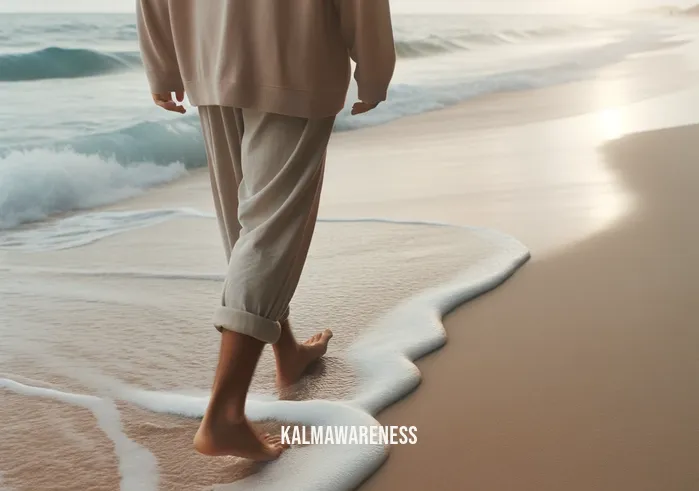Non Striving: Breathing Life into Mindfulness and Meditation
Non striving is a term that might seem counterintuitive in our modern, fast-paced world where achievement and progress are often celebrated. However, within the spheres of mindfulness, meditation, and self-improvement, non striving takes on a profound significance. It encapsulates a mindset that allows us to experience the present moment fully, without judgment or the need to change it. This mindset is not just about meditation in a quiet room but permeates every aspect of our lives. Through this series, we will dive into the vast world of non striving and explore its various facets.
What is Non Striving?
Non striving refers to the practice of not pushing ourselves to achieve a particular outcome or state during our mindfulness practices. Instead, it is about allowing experiences to unfold naturally, without the need to change or judge them. This principle encourages us to be present and embrace whatever arises in our minds during meditation or any other mindfulness activity.
In the world of mindful muscle, non striving is analogous to engaging in physical activities without obsessing over the results. Just as one would engage in a mindful martial arts session without the sole aim of winning a fight, meditation and mindfulness practices adopt a similar approach. It’s about the journey, not the destination.
Origins and Evolution
Non striving is not a new concept. It has roots in ancient traditions and cultures. Among them, ancient African meditation techniques emphasized harmony with nature and the environment, promoting a holistic approach to mindfulness. While meditation practices have evolved and transformed across centuries and cultures, the essence of non striving remains consistent.
However, in our modern era, with the influence of technology and the rapid pace of life, returning to these roots and understanding the importance of non striving has become more essential than ever. Classes like Penn mindfulness class are testament to the resurgence of these ancient principles in our modern settings.
How Does Non Striving Benefit Us?
Engaging in non striving has a myriad of benefits:
Stress Reduction: By letting go of the need to achieve a specific state or outcome, we reduce the self-induced pressure, leading to a calmer mind.
Enhanced Self-awareness: Allowing experiences to unfold naturally enables us to observe our thoughts and emotions without judgment. This practice can lead to profound insights about ourselves and our habitual thinking patterns.
Improved Mental Health: Regular practice of non striving in our mindfulness exercises can lead to improved mental well-being, decreased anxiety levels, and an increased sense of inner peace.
Physical Benefits: Coupling non striving with physical activities such as rouse yoga or mindful hiking can enhance our overall health, flexibility, and stamina.
Embracing the Present Moment
One of the essential tenets of mindfulness is the idea that “life is available only in the present moment“. Non striving ties beautifully into this, emphasizing the importance of immersing ourselves fully in the present, without getting caught up in past regrets or future anxieties. By doing so, we open ourselves to the richness of life as it unfolds, moment by moment.
“The present moment is the only moment available to us and it is the door to all moments.” – Thich Nhat Hanh
Conclusion and What Lies Ahead
Non striving is more than just a mindfulness principle. It’s a philosophy that can guide our daily lives, helping us find balance, peace, and a deeper connection with ourselves and the world around us. As we delve further into this series, we will explore various techniques, stories, and practices that embody non striving.
Whether you’re a seasoned practitioner or new to the world of mindfulness and meditation, the upcoming chapters promise a wealth of knowledge and insights. Dive into the intricacies of practices like meditation in motion and understand the transformative power of micromeditating. Learn from meditation stories for students and explore resources like mindfulness books for teens.
If you’re intrigued by the holistic potential of non striving, continue reading. The next segment

The Depths of Non Striving: Beyond Surface Understanding
Non striving, as we have established, is a cornerstone of mindfulness and meditation practices. But to genuinely grasp its profound nature, one must venture beyond the elementary definition. This chapter endeavors to delve into the intricate aspects of non striving, enriching our understanding through varied formats, and inviting you on a transformative journey.
The Science of Non Striving
Scientifically, non striving isn’t just a fancy term; it’s deeply rooted in our brain’s mechanics. When we constantly push ourselves to achieve specific outcomes, we engage the brain’s ‘fight or flight’ mechanisms, inadvertently inducing stress. Non striving offers an alternative path, shifting our focus from the outcome to the process.
Benefits of this Shift:
Neural Pathways: Our brain is plastic; it changes and adapts. Engaging in non striving rewires our neural pathways, promoting a more mindful outlook.
Reduced Stress: By reducing the constant need for achievement, we decrease the production of stress hormones, leading to better mental health.
Enhanced Focus: Absence of constant goal-oriented thinking can improve our concentration and attention span.
Emotional Regulation: With practice, non striving can aid in better emotional management and awareness.
Techniques to Cultivate Non Striving
Non striving, while simple in concept, can be challenging to practice. Here are some methods to integrate it into your life:
Mindful Observation: Spend time in nature, observing without the need to label or judge. Experience the world as it is, not as you want it to be.
Moving Meditations: Engage in activities like mindful en español or meditation pleine conscience, blending physical movement with mindfulness.
Guided Visualizations: Using tools like the mindful miracle, imagine scenarios where you’re fully present, immersing in the experience rather than the outcome.
Gratitude Practices: Incorporate routines such as gratitude yoga princeton, focusing on thankfulness and appreciation, grounding you in the present.
Seek Guidance: Engage with a meditation consultant to receive personalized guidance tailored to your journey.
The Non Striving Matrix
| Element | Description | Benefits |
|---|---|---|
| Presence | Fully being in the current moment, without distraction | Improved mental clarity, reduced anxiety |
| Acceptance | Embracing experiences without judgment | Enhanced emotional well-being, resilience |
| Observation | Passive awareness of the present experience | Increased self-awareness, better understanding of self |
| Letting Go | Releasing attachment to outcomes and goals | Reduced stress, liberation from self-imposed pressures |
| Compassionate View | Treating oneself with kindness and understanding | Improved self-esteem, healthier interpersonal relations |
Synonymous Exploration
Non striving isn’t the only term used to describe this profound state. Various cultures and traditions have their interpretations, but the essence remains consistent:
Equanimity: A balanced reaction to life’s events, neither resisting nor clinging.
Flow: Immersing fully in an activity without the conscious effort or focus on the outcome.
Acceptance: Embracing life as it is, without the urge to change or judge.
Beingness: Simply existing, without the continuous chatter of the mind.
Concluding Thoughts: Anticipating the Horizon
The art of non striving can be likened to a river—calm on the surface but profound depths underneath. As we continue our journey, you’ll discover more facets of this transformative principle. From real-world applications to individual stories of transformation, non striving unfolds as a universe in itself.
Eager to know how non striving can reshape personal relationships? Or how it influences workplace dynamics? Stay with us. Continue reading as we explore these and more in the next chapter, offering deeper insights and actionable takeaways.

Illuminating the Path: The Inspirational Power of Non Striving
In our journey of understanding non striving, it’s crucial to highlight the transformative stories and lessons this principle brings. After all, true inspiration often springs from real experiences. This chapter shines a light on hope, sharing anecdotes of individuals who have harnessed the power of non striving, and offering quotes that embody the very essence of this practice.
Real Stories of Non Striving
Lena’s Awakening: Lena, a high-powered executive, found herself at the brink of burnout. Despite her success, a constant sense of discontent plagued her. It wasn’t until she discovered mindful hiking that she recognized the beauty of simply being. Lena realized that her drive to constantly achieve left little room to appreciate the journey. Through mindful hiking, she began to immerse herself in nature, embracing each moment without the pressure of reaching a particular destination.
Carlos’s Transformation: A passionate musician, Carlos often struggled with performance anxiety. However, a chance encounter with mindful en español sessions introduced him to non striving. Instead of obsessing over the perfection of his performance, Carlos learned to connect with the music, experiencing the joy of creation without the burden of expectations.
Samira’s Journey: After a life-changing accident, Samira felt disconnected from her body. But her introduction to meditation for menopause opened the doors to non striving. By letting go of her preconceived notions about recovery, Samira tapped into her body’s innate wisdom, embracing its rhythms and signals without judgment.
Resonating Quotes of Hope and Non Striving
Thich Nhat Hanh: “There is no way to happiness; happiness is the way. There is no way to enlightenment; enlightenment is the way.”
Lao Tzu: “Nature does not hurry, yet everything is accomplished.”
Alan Watts: “Muddy water is best cleared by leaving it alone.”
Rumi: “Let yourself be silently drawn by the strange pull of what you really love. It will not lead you astray.”
Jon Kabat-Zinn: “The best way to capture moments is to pay attention. This is how we cultivate mindfulness.”
The Interconnection of Hope and Non Striving
Non striving is inherently hopeful. When we release the weight of expectations and allow experiences to unfold naturally, we create space for genuine contentment. This act can be seen in practices like a renewed mind employee portal, where individuals are taught to reconnect with their intrinsic worth, moving beyond societal pressures or definitions of success.
Equanimity, presence, and flow—synonyms of non striving—are all pathways to a hope-filled existence. By letting go, we find that the universe has a unique way of orchestrating events in our favor.
Gearing up for the Journey Ahead
While this chapter has highlighted inspirational tales of hope through non striving, the journey doesn’t end here. The next chapter will delve deeper into practical tools and strategies to integrate non striving into various aspects of our daily lives. From managing work pressures to nurturing relationships, discover how non striving can be the guiding light, leading to harmony and balance.
Whether you’re seeking tools to enhance your mindfulness practice or searching for techniques to cultivate inner peace, the next chapter promises a wealth of knowledge. Continue reading to uncover these gems and more, as we further explore the enriching world of non striving.

Dissecting Non Striving: An Analytical Exploration
As our journey continues, this chapter endeavors to present a nuanced exploration of non striving. To truly appreciate its transformative power, it’s essential to break it down, dissecting its components and understanding its manifestations in various contexts. Using concise bullet points and comprehensive lists, we’ll delve into the intricate dynamics of this mindfulness cornerstone.
Key Aspects of Non Striving
- Presence: Engaging fully in the present moment, devoid of distractions or judgments.
- Acceptance: Embracing experiences as they come, without an inherent need to change or manipulate them.
- Observation: Maintaining a passive yet conscious awareness of ongoing experiences.
- Letting Go: Releasing attachment to outcomes, results, or specific goals.
- Flow: Immersing completely in an activity, guided by intuition rather than deliberate effort.
Common Misconceptions about Non Striving
- Passivity: Non striving isn’t about inaction or passivity. Instead, it advocates for action grounded in mindfulness and awareness.
- Lack of Ambition: Embracing non striving doesn’t mean abandoning goals. It’s about pursuing them without being attached to the outcomes.
- Easy Escape: It’s not an escape from challenges but a way to face them with equanimity and balance.
- Inapplicability: Some believe non striving is only relevant for meditation. In truth, its principles can be applied to every facet of life.
Everyday Practices to Cultivate Non Striving
Mindful Breathing: Engage in moments of conscious breathing throughout the day, anchoring yourself in the present.
Active Listening: During conversations, focus entirely on the speaker, refraining from formulating responses in your head.
Mindful Eating: Savor each bite, being fully present during meals, appreciating textures, flavors, and aromas.
Mindful Movement: Activities like mindful martial arts or rouse yoga that blend physicality with awareness.
Digital Detox: Allocate specific times during the day where you disconnect from digital devices, immersing in the tangible world.
How Non Striving Influences Various Life Domains
Work: Encourages a focus on the task at hand, reducing stress and improving productivity.
Relationships: By letting go of preconceived expectations, relationships flourish in authenticity.
Personal Growth: Allows for genuine introspection and self-awareness, fostering growth not driven by societal pressures.
Health: Mental and physical health benefits from reduced stress and a holistic approach to well-being.
Learning: With the absence of performance pressure, the joy of learning is reignited, fostering curiosity.
Synonyms of Non Striving to Deepen Understanding
- Equanimity: A state of even-mindedness and balance, irrespective of situations.
- Mindfulness: Being consciously present, observing without judgment.
- Attentiveness: Paying close attention to the current experience.
- Unattachment: Engaging in actions without being bound by their results.
- Beingness: The state of simply existing, unburdened by the past or future.
Wrapping up and Peering into the Horizon
Having broken down non striving, its significance in our lives becomes even more apparent. The beauty of this practice is that it’s not a distant, abstract concept but interwoven into the fabric of our daily experiences.
But as we approach the culmination of this series, the next chapter promises to be a synthesis of our journey, encapsulating the essence of non striving and presenting actionable insights to truly integrate it into our lives. If you’ve ever wondered how to make non striving a living practice or yearn for a comprehensive summary, the concluding chapter awaits you. Continue reading to embrace the fullness of non striving.

The Journey of Non Striving: Reflections and Forward Steps
As we arrive at this juncture of our exploration into non striving, it’s an opportune moment to pause, reflect, and ponder the insights and revelations we’ve encountered. Like a comforting cup of tea at day’s end, this chapter serves as a warm wrap-up of our shared expedition, sprinkling hope and positivity for the path ahead.
Glimpses from Our Journey
The Essence of Non Striving: We unveiled the profound philosophy behind non striving, an invitation to be present, to accept, and to flow with life’s rhythm without the incessant need to control or change.
Stories of Transformation: Through tales of individuals like Lena, Carlos, and Samira, we glimpsed the life-altering power of non striving, reminding us that change, often profound, starts within.
Tools and Practices: We dived deep into tangible practices, from mindful martial arts to meditation stories for students, offering gateways to experience non striving in our daily lives.
Inspirational Quotations: Voices from diverse times and traditions echoed the timeless wisdom of non striving, providing solace and guidance for our shared journey.
Embracing Non Striving in Everyday Life
Tips to Remember:
Patience Over Pace: Remember, it’s about the journey, not the destination. Cherish each moment.
Gentle Reminders: Place reminders around your home or workspace, guiding you back to the present.
Daily Practice: Dedicate time daily, even if it’s just a few minutes, for a non striving activity, be it mindful miracle sessions or simply conscious breathing.
Join Communities: Engage with like-minded souls. Groups or classes like a renewed mind employee portal can be a beacon of support.
A Heartfelt Thank You
To each reader who embarked on this enlightening journey with us, a sincere thank you. Your curiosity, your eagerness to learn, and your commitment to personal growth have made this exploration deeply meaningful. It’s been an honor to share this space with you.
Taking the Next Steps
While this series on non striving concludes, the exploration doesn’t. Non striving isn’t just a topic; it’s a way of life, a journey that continually unfolds. And as you tread this path, remember:
“The real voyage of discovery consists not in seeking new landscapes, but in having new eyes.” – Marcel Proust
For the Curious Minds: Our magazine is brimming with more insights, stories, and tools. Whether you’re drawn to mindful hiking or wish to explore ancient African meditation techniques, there’s a wealth of knowledge waiting.
Feel the need to revisit any chapters for clarity? They’re here for you, anytime. And stay tuned! Our commitment is to continually offer enriching content, guiding you on your personal and spiritual growth.
Here’s to non striving, to being, and to many more shared journeys ahead! 🍃🌟





